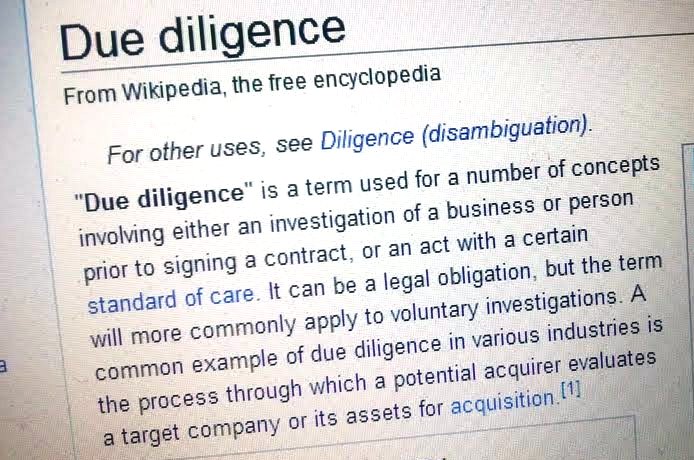 I have been doing some work on how investment professionals can use customer feedback as part of their valuation process. I include a case study of an investment firm that used customer feedback to help confirm the valuation of the target company (it did), and also where to start in terms of managing the business to secure its future.
I have been doing some work on how investment professionals can use customer feedback as part of their valuation process. I include a case study of an investment firm that used customer feedback to help confirm the valuation of the target company (it did), and also where to start in terms of managing the business to secure its future.
Investment professionals take a huge risk when they purchase or make a significant investment in a business. To identify and minimize their investment risk, these professionals conduct due diligence of the business. Due diligence is an investigation or audit of a potential investment. Investors typically examine such matters as the business’ finances, proprietary information, employees, insurance, equipment and property, and litigation claims, to name a few (Entrepreneur.com offers these due diligence questions and a downloadable checklist. Forbes has a their checklist. Inc.com has their own checklist and even offers some advice for conducting due diligence.).
While some due diligence efforts include an examination of customer data, they typically focus on identifying the number and types of customers (e.g., where they are located, size). Even in cases where customer feedback is included in the due diligence process, the business sellers hand-pick a few customers to be interviewed by the buyer, resulting in potentially biased information about the health of the business and inflating the perceived value of the business. If customer feedback is to be of value, a more rigorous approach using customer feedback is needed. In this post, I will outline a more in-depth approach at using systematic customer feedback in the due diligence process.
1. Ask a Representative Sample of Customers
When soliciting customer feedback, take steps to ensure the feedback is representative of all possible feedback from the population of customers. Ask for a complete customer list from the seller and randomly select the customers you want to give you feedback. If you are particularly concerned about specific customer segments, use stratified random sampling (random selection occurs within each customer segment) to ensure you get enough respondents for the segments in question.
While a census is unnecessary to get a reliable picture of the entire customer base, I recommend that, when possible, you invite all customers to provide feedback. For B2C companies, surveys need to be targeted to the buyer of the products/services. For B2B companies, due to the nature of the buying process, surveys need to be targeted to all parties who are directly and indirectly involved in buying the company’s products/services (e.g., decision makers and decision influencers).
Verify the quality of the sample of customers by comparing the demographic make-up of the sample to that of the entire customer base. The extent to which the sample is representative of the population will determine the quality of the inferences you are able to make about the population. To make any meaningful conclusions about the value of the target company, the customers you ask need to be a representative sample of the population of customers.
2. Ask about Customer Loyalty
The value of a company in directly impacted by customer loyalty. The greater the customer loyalty, the higher the company value. Customers can increase the value of a company by engaging in three different types of customer loyalty behaviors. As is illustrated in the Customer Loyalty Measurement Framework, these three types of customer loyalty include: 1) retention loyalty (valuable customers stay around for a long time), 2) advocacy loyalty (customers tell family/friends about the company to drive new customer growth) and 3) purchasing loyalty (customers increase their share-of-wallet to drive average revenue per user/customer (ARPU) growth).
Because customers can exhibit their loyalty to a company in different ways, you need to ask the right loyalty for your specific needs. Does the target company have a history of high defection rates? If so, ask customers about their intention of staying. Does the target company have stagnant ARPU growth? If so, ask customers about their intention of buying different products. Does the target company historically have low new customer growth? If so, ask customers about their intention of recommending the company to their friends.
As a starting point, consider including a loyalty question for each of the three general types of loyalty behaviors: retention, advocacy and purchasing (see the RAPID loyalty):
- Likelihood to switch providers (retention)
- Likelihood to renew service contract (retention)
- Likelihood to recommend (advocacy)
- Overall satisfaction (advocacy)
- Likelihood to purchase different solutions from <Company Name> (purchasing)
- Likelihood to expand use of <Company Name’s> products throughout company (purchasing)
3. Ask about Customer Experience (CX)
Customer loyalty is impacted by the customer experience. According to Wikipedia, the customer experience (CX) is the sum of all experiences a customer has with a supplier of goods and services over the duration of that relationship. Customers who are satisfied with their experience with the supplier stay longer, recommend more, and buy more from the supplier compared to customers who are less satisfied with their experience.
Ask customers about their experience with the company. While you could ask customers literally hundreds of CX questions about each specific aspect of their experience, research shows that you only need a few CX questions to understand what drives their loyalty. For example, ask customers how satisfied the are with the target company across each of these areas:
- Ease of doing business
- Product quality
- Account Management/Sales
- Customer service
- Technical support
- Communications from the Company
- Future Product/Company Direction
4. Ask about Relative Performance
Companies do not perform in a vacuum; competitors are vying for the same customers and limited prospects as the target company you are purchasing. If the target company has plenty of competitors in its space, you need to understand where you rank relative to the competition. After all, top ranked companies receive greater share of wallet compared to their bottom-ranked competitors. All things equal, a company that is ranked the lowest is less valuable than a company that is ranked the highest.
Ask customers about how the company compares to its competitors. Toward that end, the Relative Performance Assessment (RPA), a competitive analytics solution, helps investors understand the relative ranking of the target company and identify ways to increase their ranking, and consequently, increase share of wallet. In its basic form, the RPA method requires two questions:
- What best describes Company’s performance compared to the competitors you use?
- Please tell us why you rank Company’s performance the way you do. This question allows each customer to indicate the reasons behind his/her response about your ranking. The content of the customers’ comments can be examined to identify underlying themes to help diagnose the reasons for high rankings or low rankings
To understand the value of the company you are purchasing, you need to know how you measure up to the competition. More importantly, after the purchase, the RPA will help you know what you need to do to improve your ranking in the industry.
5. Ask about Company-Specific Issues
Investors may have a need to ask additional questions that are specific to the target company. These questions, driven by specific business needs, can include demographic questions (if not included in their CRM system), open-ended questions, and targeted questions. Typical questions in B2B relationship surveys include:
- Time as a customer
- Job function (e.g., Marketing, Sales, IT, Service)
- Job level (executive, director, manager, individual contributor)
- Level of influence in purchasing decisions of <Company Name> solutions (Primary decision maker, Decision influencer, No influence)
Include one or two open-ended questions that allow respondents to provide additional feedback in their own words. Depending on how the questions are phrased, customers’ remarks can provide additional insight about the health of the customer relationship. Text analytics help you understand both the primary content of words as well as the sentiment behind them. To understand potential improvement areas, a question I commonly use is:
- If you were in charge of <Company Name>, what improvements, if any, would you make?
Customer relationship surveys can be used to collect feedback about specific topics that are of interest to executive management. Give careful consideration about asking additional questions. As with any survey question, you must know exactly how the data from the questions will be used to improve customer loyalty. Some popular topics of interest include measuring 1) perceived benefits of solutions and 2) perceived value. Some sample questions are:
- How much improvement did you experience in productivity due to <Company Name’s> solutions?
- Satisfaction with price of the solution given the value received
Next, I will present an example of how one investment firm used customer feedback to help in their due diligence process.
Case Study
An investment firm wanted to expand their portfolio of companies by purchasing an existing B2B company. As part of the due diligence process, the investment firm worked with the target company to acquire their customer email list for a Web-based customer survey. The investment firm used the Customer Relationship Diagnostic (CRD) to collect customer feedback. The CRD is a brief survey that asks customers about different types of customer loyalty, satisfaction with general CX touch points, relative performance and a few company-specific questions.
The response rate for the survey was about 70% and consisted primarily of decision makers and decision influencers (~80%) and were Managers, Directors or Executives (~70%).
Case Study: Loyalty Results
Customer loyalty results are located in Figure 1. As you can see, customers reported moderate levels of customer loyalty for most of the loyalty questions (e.g., advocacy and retention). For purchasing loyalty, customers reported low likelihood of buying different products and low likelihood of expanding the use of the target company’s solutions.
Case Study: CX Results
Results of the CX ratings can be found in Figure 2. Based on the survey results, the customers were moderately satisfied with their experiences across the touch points, except for Communications from the Company and Future Product/Company Direction.
Between 20% and 50% of the customers said they were dissatisfied with each of the seven customer touch points.
Case Study: Relative Performance Assessment Results
Results of the Relative Performance Assessment ratings are located in Figure 3. As you can see, customers said that only 42% of the customers indicated that the company was better than the competition. Almost 60% of the customers indicated that the company was the same worse than most other competitors.
After re-scaling the values of the 5-p0int rating scale (1 = worst to 5 = best) to a 0-100 scale, I estimated that the target company falls roughly at the 54th percentile in their industry; that is, the company’s performance is typical when compared to their competition.
Case Study: Determining Dollar Value of Loyalty
To estimate the expected revenue gains/losses of the target company, I worked with the investment firm to translate the customer loyalty ratings into a dollar value. We employed subject matter experts (SMEs) as well as analyzed existing financial reports of the target company to arrive at our best guess of expected annual revenue gains through new customers (~$300k)) and existing customers (through purchasing new/different products – ~$160k) and estimated the annual revenue at risk due to churn (by customers stop using the company ~ $450k).
Case Study: The Decision
Overall, the customer feedback confirmed the valuation of the company. While the target company was perceived to be in the middle of the pack in their industry (ranked at 54th percentile) and the future direction of their products/company appeared dismal (50% are dissatisfied), investors believed they had the management team that could address these shortcomings. The investment company decided to buy the company.
Case Study: Where to Make Improvements
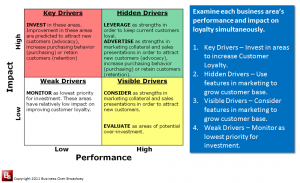
Figure 4. Driver Matrix help you identify the best areas to allocate company resources (e.g., money, time) to maximize ROI of your investment dollars.
The investors now became the business owner, and, consequently, needed to manage the business to secure its future. The survey results were analyzed to help decide where to best allocate resources in areas that will improve customer loyalty (and revenue) while minimizing the improvement costs.
Using driver analysis on the existing data, the investment firm found that there were three key drivers of customer loyalty: 1) product quality, 2) communications from the company and 3) future product/company direction. Again, using SMEs, we were able to estimate the ROI for improving each of the three key drivers. It turns out that the greatest ROI for CX improvements would be achieved by improving communications from the company and future product/company direction.
Benefits of Using Customer Feedback in your Due Diligence Process
You can significantly enhance your due diligence process through a systematic approach of collecting and analyzing customer feedback. Using the questions I proposed above, here are some benefits you can achieve when you use customer feedback as part of your due diligence process when purchasing a company:
- Identify investment opportunities others miss and avoid investing in poor opportunities. Discover the quality of products and services from the people who matter: The customers.
- Estimate revenue gains/losses. Using survey data and financial data, you can estimate annual revenue at risk due to customer churn and revenue growth due to new customers and expanding relationships with current customers.
- Understand your competitive advantage/disadvantage. Your relative performance will impact how much incremental money your customers will spend with you. Collecting customer feedback can help you identify what you need to do to beat your competition to improve your growth.
- Understand the ROI of different improvement efforts.
Summary
Investors can gain valuable insight about a target company they are buying by simply asking customers the right questions. Be sure you ask a representative sample of customers so the feedback you get is meaningful and reflects the entire customer base. Ask customers about different types of loyalty behaviors in which they are likely to engage. This feedback can help you estimate revenue gains and risks. Ask customers about their customer experience to identify company strengths as well as potential problems. Ask customers about the company’s relative performance compared to other companies. This insight can help you understand the competitive landscape in the company’s industry and identify ways to improve/maintain your competitive advantage.
When purchasing a company, a systematic approach to surveying the customers (and analyzing the data correctly) can significantly augment the information in your due diligence process and provide a lot of insight about the value of the company. Asking the customers of the target company could mean the difference between acquiring a valuable company or a lemon.
Learn more about the Customer Relationship Diagnostic (CRD) for your due diligence
To learn more about the Customer Relationship Diagnostic, please complete the form below.
[si-contact-form form=’1′]


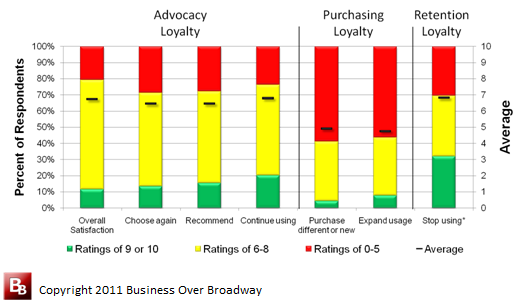
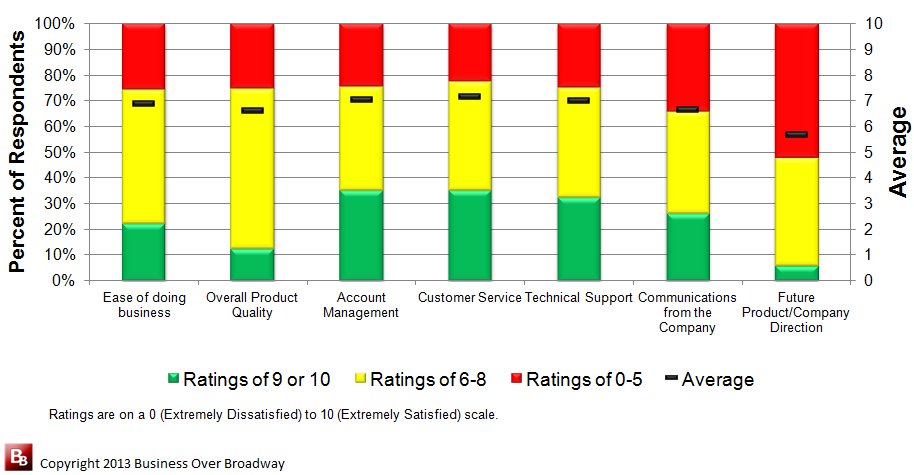
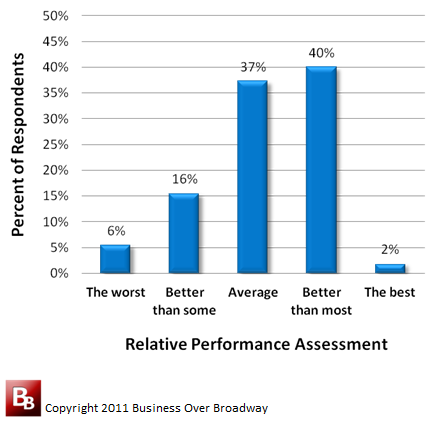

 Beyond the Ultimate Question
Beyond the Ultimate Question Measuring Customer Satisfaction and Loyalty (3rd Ed.)
Measuring Customer Satisfaction and Loyalty (3rd Ed.)
Comments are closed.